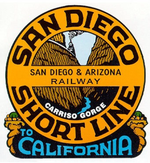 | |
| Overview | |
|---|---|
| Headquarters | San Diego, California |
| Reporting mark | SDA |
| Locale | California Mexico |
| Dates of operation | 1919–1933 |
| Successor | San Diego and Arizona Eastern Railway |
| Technical | |
| Track gauge | 4 ft 8+1⁄2 in (1,435 mm) standard gauge |
| Length | 129 miles (208 kilometers) |
The San Diego and Arizona Railway (reporting mark SDA) was a 148-mile (238 km) short line U.S. railroad founded by entrepreneur John D. Spreckels, and dubbed "The Impossible Railroad" by engineers of its day due to the immense logistical challenges involved. It linked San Diego, its western terminus, with El Centro, its eastern terminus, where passengers could connect with Southern Pacific's transcontinental lines, eliminating the need to first travel north via Los Angeles or Riverside.
The company charter was executed on December 14, 1906, and the groundbreaking ceremony was held the following September. Numerous delays (including government intervention during World War I) delayed the completion of the line to November 15, 1919. Damage to the lines from both natural disasters and sabotage exerted great financial pressure on the company, and in 1932 Spreckels' heirs sold their interests in the railroad to the Southern Pacific, which changed the name to San Diego & Arizona Eastern Railway (SD&AE).